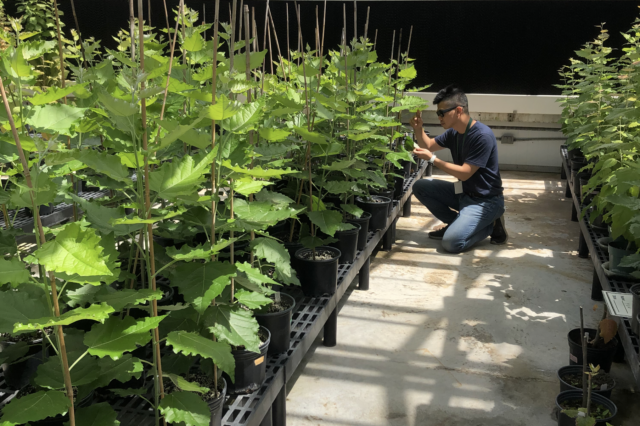
UGA graduate student Yen-Ho Chen evaluates poplar trees during a greenhouse experiment. Credit: Yen-Ho Chen/UGA
A recent study funded through the Center for Bioenergy Innovation provided an enhanced picture of the function of a key protein in tree leaves. These findings build toward a broader effort to make trees more resilient to stress, such as droughts brought on by climate change.
Researchers at the University of Georgia sought to more fully understand the role of a protein that transports sucrose, manufactured by leaves during photosynthesis, to the roots and trunk of the trees as nourishment. They had already found that suppressing this protein, called PtaSUT4, caused sugar to accumulate in the leaves without any apparent negative side effects. They were interested to find that more water remained in the leaves, too.
“We began to think the protein might have to do with hydraulics also,” said lead researcher Scott Harding, a senior research scientist at UGA’s Warnell School of Forestry and Natural Resources. “People have not really thought of sucrose transporters as having effects on plant water use. Those are the basic questions we’re interested in.”
To find out more, his team grew the protein-suppressed poplar as well as wild strains in a greenhouse. They partially removed the leaves to observe how the remaining leaves responded in terms of making energy from the sun, drawing water up through the roots, and releasing water vapor into the atmosphere, among other functions. The results were recently published in Plant Direct.
Normally, when a plant loses many of its leaves, those that remain try to pick up the slack by increasing photosynthesis and transpiration – basically, making more food and “breathing out” more water vapor and carbon dioxide. Researchers found that the wild-type poplar did this better. It demonstrated more shoot growth, water uptake and transpiration after defoliation than the genetically modified poplar. However, the modified poplar with the suppressed sugar transporter was able to hold more water and sugar in its leaves. It also retained greater leaf stiffness, a measure called turgor – essentially, the leaves take longer to wilt and die.
Harding and his colleagues are now exploring whether this sucrose transporter plays an important role in how trees adjust to changes in nutrient and water availability.
“We may be able to use these lines to obtain more basic information about how sucrose and water use are balanced against each other, for enabling trees to do well in variable environments,” Harding said. This is significant because bioengineering plants that can absorb more water – and with it, nutrients – could make them hardier in the face of drought, attacks by tree pests, and other conditions that cause leaf loss.
Scientists could also build on these findings to benefit the productivity of tree farms. For example, when trees are crowded together, they may have fewer leaves because competition reduces their water uptake. Trees whose leaves could store more water would have an advantage.
The Center for Bioenergy Innovation (CBI) at ORNL is one of four DOE Bioenergy Research Centers focused on advancing biofuels and bioproducts for a vibrant domestic bioeconomy. CBI is accelerating the development of bioenergy-relevant plants and microbes to enable production of drop-in sustainable aviation fuel, bioproducts that sequester carbon, and sustainable replacements for plastics and other environmentally harmful products. CBI research is supported by the Biological and Environmental Research program in DOE’s Office of Science.
